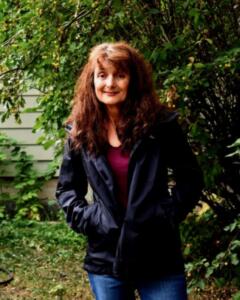1958 Shades and perplexities of blue
Sapphire and the Hollow Bone
by Diana Hayes
Victoria: Ekstasis Editions, 2023
$23.95 / 9781771715192
Reviewed by gillian harding-russell
*
 Meditative and elegiac in its imagery and moods and finding resonances in mythology, Diana Hayes’ Sapphire and the Hollow Bone is imbued with the colour blue. Whether such details as the cherished gift of a “star sapphire,” “aqua therapy” for a thalidomide child in a “blue gown,” or “indigo skies” in a nature poem, the colour’s variations acquire the quality of a motif.
Meditative and elegiac in its imagery and moods and finding resonances in mythology, Diana Hayes’ Sapphire and the Hollow Bone is imbued with the colour blue. Whether such details as the cherished gift of a “star sapphire,” “aqua therapy” for a thalidomide child in a “blue gown,” or “indigo skies” in a nature poem, the colour’s variations acquire the quality of a motif.
The cover design with a detail from The Frozen Sea Within, an acrylic and collage by Phyllis Webb, presents a scene with a shed under a blue moonscape that in letting off light from its cracks epitomizes the burning inwardness of Hayes’ speaker. In the opening sequence about the speaker’s mother’s ordeal with cancer, Hayes accordingly evokes the Buddhist Goddess of Mercy, Kuan Yin in association with the moon.
Here is a wide-ranging collection, the vision mature with the speaker finding solace in nature in “The Wild Absence of Time,” mournful and full of love for horses in “Equine Elegies,” and pithy and wise with an awareness of life’s intensities and brevities in “Twenty-Two Ghazals for Phyllis Webb.”
In the first poem of the collection, “Corycean’s Half-Light,” Salt Spring Island’s Hayes takes us to legendary caves that led to the underground setting where the Delphic priestess would pronounce her oracles to renowned figures of Ancient Greece. As the speaker, a tourist, “loops along/ the southern slope of Mount Parnassus,” readers take a modern journey. The poem ends with the tableau of a young girl in “Delphi’s stadium” who performs an “immaculate dash headstrong”–that perhaps foreshadows the poet-speaker whom we later learn is also an athlete and a swimmer in “Swimming Maria’s Island.”
After this poem, a tableau in “The Day My Mother’s Breast Was Cut Off” wrenches the reader with austere present reality as the speaker waits on the grass outside St. Mary’s in Kerrisdale for her father to tell her the “knife – let’s not call it / a scalpel” “was no longer slicing through decades of memory,” where her mother at one time danced “in taffeta gowns / handstitched vests, a Wren’s hat / worn on the winter prairie” before “a firstborn daughter,” and when she did not yet know “how cells could go so rogue.”
Here, the blue motif recurs in the form of a “carpet of hyacinth” as the speaker’s “right breast burn[s] blue/ beneath her blouse” in sympathy. The details of her mother’s dress reflect her easy elegance against a harsh “winter prairie” landscape.

In Hayes’ title poem, the mother’s internment is presented through the eyes of the attending speaker, and is both rueful and contemplative. As the chaplain pours ashes from an urn–a Ming vase the speaker cherished during her life–the speaker glimpses “a turquoise hue” in the “blue gem of bone” and ashes. She’s reminded of the star sapphire ring that her mother gifted her on coming of age. As both prayer and blessing, the speaker invokes verses from Rumi in the closing lines: “this garden now yours– / the empty reed / the hollow bone.”
In an iconic image, the “wind” that is drawn through the reed to become “fire” (and to express musical passion) evokes the transcendent nature of music and poetry. And the title for the collection, Sapphire and the Hollow Bone, gathers meaning and intensity.
Entering the second section, “The Wild Absence of Time,” the poems are more varied in their themes and subjects. They range from the lively and imaginative “Dreaming of Cats in the British Museum” to the whimsical “Raven and my Tourmaline Earring.” Hayes nods to nature and Emily Carr in “Speak to the Earth” and includes a pantoum—a poetic form originating in fifteenth-century Malaysia—written during the pandemic and aptly titled “Pandemic Pantoum.”
In one of the most touching poems for me, “Swimming with Susan,” the speaker, as a play-therapist, interacts with the young girl whose missing limbs are deformed due to “thalidomide stealing them”:
just a round tiny torso
and a shock of blonde hair
the secret flippers tucked
beneath a blue gown
eager for aqua therapy.
A rush of the speaker’s feelings comes through in the final stanza—“my useless sorrow and candy-striper’s smock.” They’re shown to be insufficient props against personal weakness, while her “saltwater tears” fall into the “therapy pool.” Meanwhile, the girl “Susan’s laughter commands the room.” This “water baby” knows no other world, and finds the water both liberating and exhilarating. Even in this poem, “aqua” is a shade of blue but replete with joy and redemption, and the child significantly wears a blue gown.
The title for the section “The Wild Absence of Time” captures the speaker’s connection to nature during troubled moments and times. Again, shades of blue enter the poem, here in an exquisite palette, from the “purple martens” to the “amber sky” that “paints an indigo / so deep and clear”:
leaving me to breathe
the scent of dusk
this holy earth
the wild absence of time.
The short cadences dramatize the speaker’s breath and her inhalations with their short but incisive epiphanies. As so often in Hayes’ poems, nature and spirituality entwine in her meditation while they offer beauty and aesthetic removed from the mundane.
In the closing sections, “Equine Elegies” and “Twenty-Two Ghazals for Phyllis Webb,” the poems take related but divergent thematic turns: first, into the animal world with prose-poems in memory of horses the speaker or her relatives have owned or known; and, second, into a pithy minimalism that the ghazal—historically a medieval Arabic verse form about loss and romantic love—performs in honour of life’s knottier paradoxes and perplexities/complexities.
One of my favourite ghazals is “XII,” with its the commonsensical realization that, after a period of sadness or loss, life continues:
Love is perennial and will breed again. Mourn well.
Grief bathes the lungs. Broken hearts repair between beats.
The stark realization that “no one comes back from the underbelly unscathed” is followed by affirmation that healing does happen and life must go on. Here the ghazal form binds strong emotion in precise couplets presented as hard truths that counter sentimentality.
Sapphire and the Hollow Bone is a rich and varied collection with a mature vision. Rather like Webb’s The Frozen Sea Within, the collection may be seen as a collage in which discrete but related sections placed next to each other enrich our impression of the whole.
*

A poet, editor, and reviewer, gillian harding-russell lives on Treaty 4 territory. Her most recent collections include In Another Air (Radiant Press, 2018) and Uninterrupted (Ekstasis Editions, 2020). Also, a chapbook, Megrim, was released by The Alfred Gustav Press in 2021. [Editor’s note: gillian harding-russell recently wrote about collections by Susan McCaslin, Marlene Grand Maître, and Ian Thomas in BCR.]
*
The British Columbia Review
Interim Editors, 2023-24: Trevor Marc Hughes (non-fiction), Brett Josef Grubisic (fiction)
Publisher: Richard Mackie
Formerly The Ormsby Review, The British Columbia Review is an on-line book review and journal service for BC writers and readers. The Advisory Board now consists of Jean Barman, Wade Davis, Robin Fisher, Barry Gough, Hugh Johnston, Kathy Mezei, Patricia Roy, Maria Tippett, and Graeme Wynn. Provincial Government Patron (since September 2018): Creative BC. Honorary Patron: Yosef Wosk. Scholarly Patron: SFU Graduate Liberal Studies. The British Columbia Review was founded in 2016 by Richard Mackie and Alan Twigg.
“Only connect.” – E.M. Forster
3 comments on “1958 Shades and perplexities of blue”
What an insightful, thorough, and well-supported review by gillian harding-Russell! She penetrates to the heart of Diana Hayes’ excellent Sapphire and the Hollow Bone.